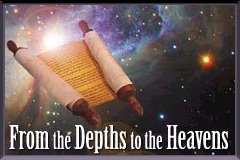|
The Columbia and the
Torah |
|
This is the history of that Torah: The bar mitzvah took place before dawn on a Tuesday, in March 1944, deep inside a barracks at the Bergen-Belsen concentration camp. Those men who were strong enough covered the windows and doors with blankets, and stood watch to make sure the SS guards weren't coming. Four candles, scrounged from somewhere, gave off enough flickering light for Rabbi Simon Dasberg to unfurl his tiny Sefer Torah -- the five books of Moses, handwritten in Hebrew on a parchment scroll just 4 1/2 inches tall. Thirteen-year-old Joachim Joseph chanted the blessings just as the rabbi had taught him, and he chanted aloud from the ancient text in the singsong Hebrew that has been passed down for hundreds of years. "There were people listening in the beds all around," Joseph, now a 71-year-old Israeli physicist, recalls, describing the narrow, triple-decker bunks where the Jewish men and boys were forced to double up. "Afterwards, everybody congratulated me. Somebody fished out a piece of chocolate that he had been saving, and somebody else fished out a tiny deck of playing cards. Everybody told me, 'You are a bar mitzvah boy now. You are an adult now.' And I was very happy. And then everything was taken down, and we went out to morning roll call." Dasberg also gave Joseph a gift: the miniature Torah scroll, covered in a red velvet wrapper and tucked into a small green box. (A full-size Torah, by contrast, is closer to three feet tall, with the girth of a fire hydrant.) "He said, 'This little Sefer Torah is yours to keep now, because I'm sure that I will not get out of here alive. And you maybe will,' " Joseph remembers. "And, you know how children are, I didn't want to take it. But he convinced me. And the condition was, I must tell the story."
The story of the Torah was told to the world on Jan. 21, 2003 when Israeli astronaut Ilan Ramon held the scroll aloft during a live teleconference from aboard the space shuttle Columbia. "This was given by a rabbi to a scared, thin young boy in Bergen-Belsen," Ramon, whose mother survived Auschwitz, said from the space shuttle. "It represents, more than anything, the ability of the Jewish people to survive. From horrible periods, black days, to reach periods of hope and belief in the future." When the shuttle disintegrated as it reentered Earth's atmosphere 11 days later, Ramon and the six other astronauts were killed, and the Torah was almost definitely destroyed. But the story of the tiny scroll was reborn. It is the story of a generation that experienced the worst humanity has to offer, a generation that, 60 years later, is rapidly dying off, leaving only its youngest survivors, museum exhibits and history books to give witness. Ramon had noticed the Torah on a shelf in Joseph's study two years ago while visiting his apartment in Tel Aviv. The astronaut and the scientist were working on experiments that would be performed on the space shuttle, and they had become friends. Ramon asked about the scroll. Weeks later, he phoned Joseph from Houston and asked permission to carry the Torah into space. Joseph agreed immediately, happy for another chance to make good on his promise from long ago. Born in Berlin and raised in Amsterdam, Joseph had watched with interest as older boys in his neighborhood celebrated their bar mitzvahs, the rite of passage marking the onset of Jewish manhood. His father, a lawyer and businessman, was not religious, but several uncles were, and they frequently took Joseph and his younger brother to synagogue. Joseph was not particularly dedicated to the Jewish rituals, but he did look forward to experiencing the excitement of becoming a bar mitzvah, literally a son of the commandment. Then the Nazis came. The family was sent to a Dutch prison camp called Westerbork late in 1942. A year later, the Josephs were brought to Bergen-Belsen, the concentration camp in the Lower Saxony region of Germany where 50,000 died, including Anne Frank. Joseph's father and mother were sent to different sections of the camp. He and his younger brother ended up in a barracks with Dasberg, a 42-year-old rabbi who had been deported two years earlier when he was chief rabbi of the Netherlands. Written and oral accounts from survivors, including Dasberg's brother, describe how the rabbi brought Jewish texts with him to Bergen-Belsen and tried to study and pray from them every day. Such practices were often permitted at the camp in 1942 and 1943, says Severin Hochberg, a historian from the U.S. Holocaust Memorial Museum. Jews would quietly recite daily prayers, sing Sabbath songs or share a bit of bread to mark the Passover Seder, Hochberg says. It was not unheard of for rabbis to have religious books and ritual objects with them, he adds, although he had not heard specifically of another Torah scroll hidden in the camps. Rabbi Raphael Malka, a scribe from Silver Spring who has repaired Torahs large and small, said the miniature ones are usually commissioned by wealthy individuals for use at home or while traveling. They can be worth from $12,000 to $30,000 today, depending on their condition. By 1944, conditions at the camp were steadily worsening. A diary entry by a Dutch Jew describes how Dasberg and others were caught gathering at the gates of the camp crematorium to recite the Kaddish (go see the words), the Jewish prayer for the dead. They were punished with extra hard labor. When Dasberg learned that Joseph was 13, the age of bar mitzvah, he asked if he could teach him to read from the miniature Torah. They studied together secretly at night. "We were still in a good enough condition that we would entertain the thought of such a thing," Joseph remembers. As Joseph recalls it, Dasberg disappeared from his barracks a couple of months later. Historical records show that the rabbi survived until Feb. 24, 1945, less than two months before British troops arrived to liberate the camp. Joseph used rags to wrap the green velveteen box that held the Torah, and stuck it deep down in his backpack. It stayed there, undetected, as conditions in the camp grew grimmer.
As he approached his 14th birthday, he weighed just 42 pounds. His feet, protected only by rags, rope, and two chunks of an old tire, froze in the winter cold. When he could no longer join the regular work detail, he was given a less physically demanding assignment. After morning roll call, he would limp from bunk to bunk, checking to see if those still in bed were alive. He then dragged the corpses outside and waited for a cart to come by, so he could load them on. Freedom came out of the blue in February 1945. A maternal uncle who had fought for the French Resistance and then escaped to Switzerland secured fake passports for Joseph's family from several Latin American countries -- an extreme rarity so late in the war. The brothers and their parents, all emaciated and near death, were reunited on a train full of captured foreign nationals, whom the Germans hoped to exchange for their own POWs. Months later, the family sailed on a British military ship to Palestine, part of a generation of refugees determined to build a Jewish state. In 1951, Joseph published a first-person account of his clandestine bar mitzvah in the English-language Jerusalem Post. He hated talking about the camps and he didn't want to write the article, but his father, who knew of the promise his son had made, insisted. For the next four decades Joseph said nothing about his experiences. He wanted to stop the nightmares he kept having. He wanted to move on. "I screwed it down, deep down," he says. "I managed to forget it." He studied atmospheric physics, receiving a doctorate from UCLA in 1966. He pioneered experiments in how dust particles in the atmosphere affect the climate. He opened the Torah periodically just to look at it, but he never read from it. Nine years ago, when his oldest grandchildren were 6 and 8, Joseph took out the Torah and decided he was ready to tell the story once more. As he says all this today, there is noise in the background. His youngest grandchildren are visiting his apartment, and they want him to come and play. There are five grandchildren in all, a new generation. Joseph says he has no regrets about sending the Torah into space. "I'm not sorry that it is gone," he says. "It did what it, perhaps, was destined to do." This article originally appeared in the Washington Post.
Special article
about the Torah
|

 Israel's
first astronaut, Ilan Ramon, took a small
Israel's
first astronaut, Ilan Ramon, took a small 
